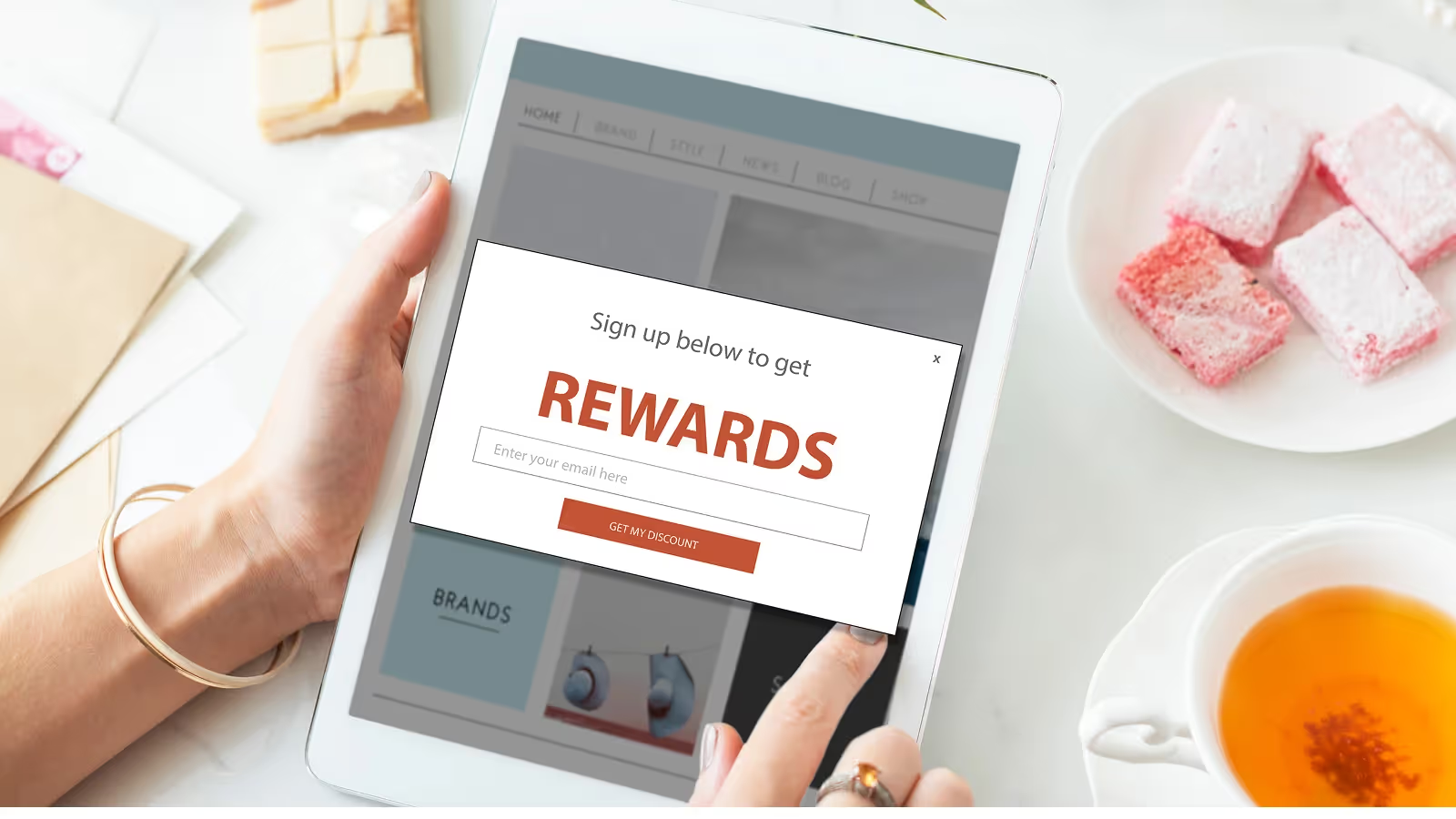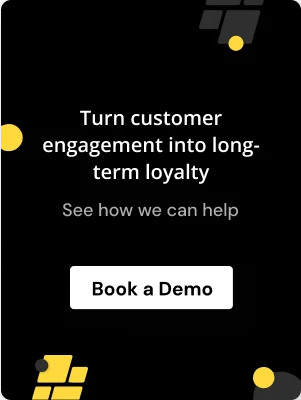.avif)
.avif)
Recognition and loyalty programs are under pressure to evolve. Handing out the same gift vouchers every quarter doesn’t resonate with employees, and customers no longer stay loyal for basic catalog rewards. They expect rewards to be instant, personal, and meaningful, something traditional programs rarely deliver.
The gap between expectations and reality is significant. A High-Impact Rewards study found that top-performing organizations are 1.7 times more likely to make recognition a core part of their rewards strategy compared to their lower-performing peers. Only 2% of organizations viewed employee recognition as a competitive advantage, while nearly a third didn’t see it as a differentiator at all.
For e-commerce brands, retention is a blind spot that’s costing real growth. Nearly 80% of a firm’s future profits will derive from 20% of existing customers, yet many brands still pour the bulk of their budgets into one-time acquisition campaigns. It’s a costly imbalance, especially when the customers you already have are the ones most likely to buy again.
In this blog, we’ll explore what digital rewards really are, the types that work best for e-commerce brands, why they drive meaningful results, and how to implement them in ways that lead to measurable growth, not just surface-level success.
TL;DR
- Digital rewards work better than traditional ones. Options like gift cards, wallet credits, points, and experiences provide immediacy and flexibility.
- They meet modern expectations by giving employees and customers rewards they can use quickly and in ways that feel personal.
- Clear objectives are critical to define what you want to achieve (e.g., higher retention, stronger engagement) before rolling out a program.
- Security and compliance matter; choose platforms that protect personal data and meet regulatory standards.
- Automation makes it a scalable tools that handle tracking, delivery, and analytics, freeing your team to focus on strategy.
- When done well, digital rewards can significantly boost employee morale and strengthen customer loyalty.
What Are Digital Rewards?
Digital rewards are incentives delivered electronically to employees, customers, or partners through channels like email, in-app notifications, or mobile wallets. Unlike physical gifts or paper vouchers, they arrive instantly and are simple to redeem, which makes them far more relevant in a world that values speed and convenience.
But this shift is about more than efficiency. Timely recognition changes behavior. For employees, a quick reward after a major contribution reinforces the right actions at the right time. For customers, it transforms a one-off transaction into the start of a longer relationship with your brand.
Why It Matters for Businesses
Digital rewards go beyond delivery convenience. They give you real-time visibility into how people engage with your program, redemption rates, participation levels, and overall impact. This data helps you refine your strategy instead of relying on guesswork.
In essence, digital rewards create a feedback loop: participants feel seen and appreciated immediately, while your business gains actionable insights to improve retention, engagement, and overall program effectiveness. But for that impact to last, the rewards themselves need to feel relevant and motivating. That’s where choosing the right types of digital rewards comes in.
Types of Digital Rewards Options for Employees and Customers
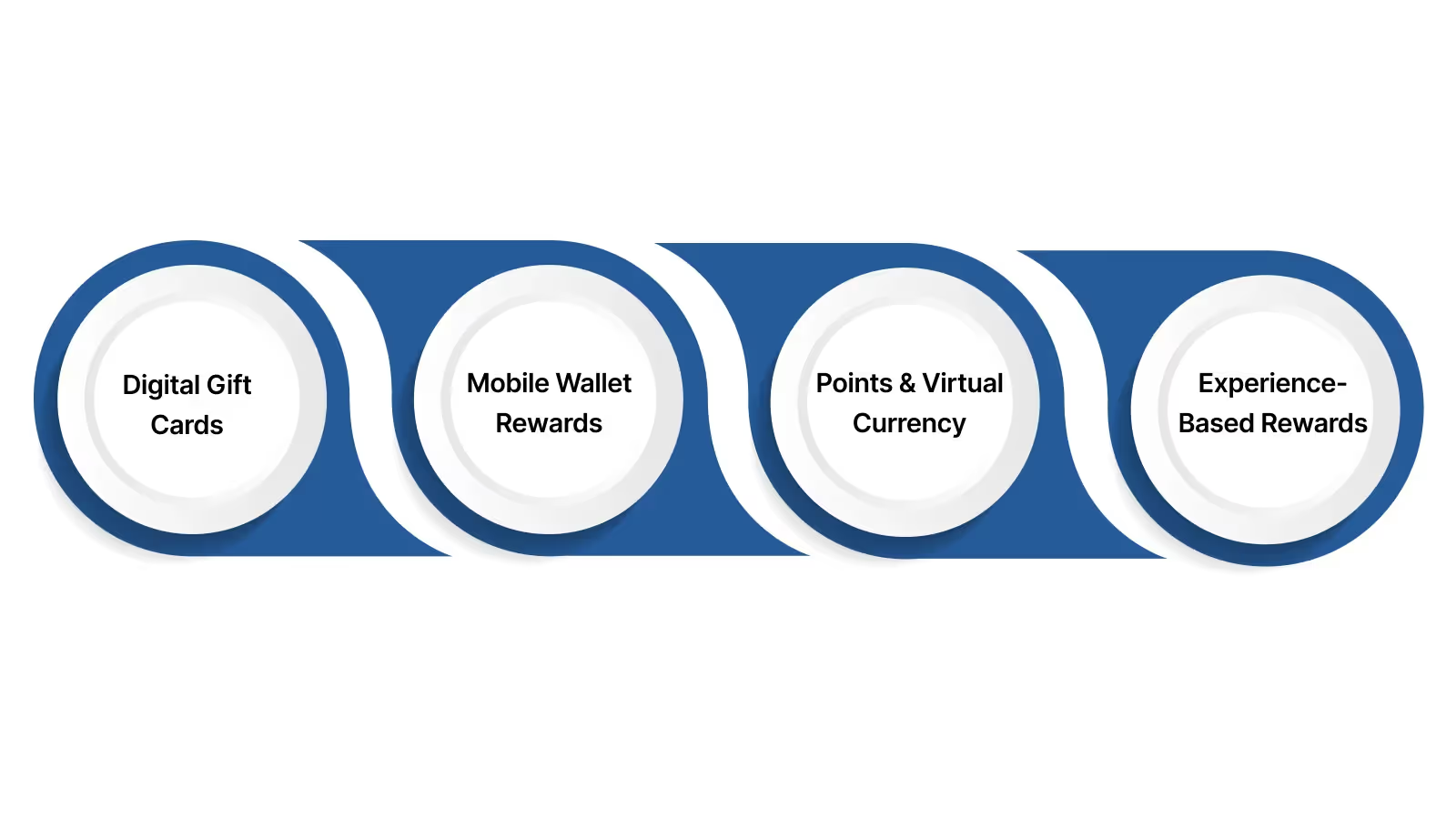
Choosing the right reward starts with understanding two things: who you’re rewarding and what motivates them. A high-performing employee seeking recognition for hard work and a loyal customer making repeat purchases value rewards in very different ways. Designing a program without considering these differences often leads to low engagement. Here’s a breakdown of the main types, with examples of how they work for employees and customers.
1. Digital Gift Cards
Gift cards remain one of the most adaptable reward options because they give recipients freedom of choice. In fact, nearly 80% of people say they’d prefer a gift card as a reward from their employer, showing just how widely appreciated and versatile gift cards really are. Instead of receiving a one-size-fits-all gift, employees and customers can pick something meaningful to them, whether it’s a favorite retailer, an entertainment subscription, or store credits for their next purchase.
When to use for employees:
- Recognizing quarterly performance milestones, where a public “thank you” alone may not feel sufficient.
- Celebrating personal occasions like birthdays or work anniversaries in a way that feels personal but easy to scale.
- Incentivizing professional development, such as completing optional training or certifications.
When to use for customers:
- Rewarding high-value purchases by turning them into a tangible benefit (like store credits).
- Encouraging referrals by offering gift cards that are easy to redeem.
- Driving survey completions or product feedback with small but immediate incentives.
2. Mobile Wallet Rewards
Mobile wallet rewards integrate seamlessly into Apple Pay, Google Pay, or similar platforms, which eliminates the usual friction of managing codes or physical vouchers. For employees and customers alike, these rewards feel instant and usable, ideal for today’s mobile-first audience.
When to use for employees:
- Spot recognition for outstanding contributions without waiting for a formal review cycle.
- Encouraging peer-to-peer recognition, where colleagues can instantly acknowledge one another.
- Driving participation in engagement initiatives like wellness challenges or optional company events.
When to use for customers:
- Offering referral bonuses that can be used right away, an instant thank-you that reinforces their advocacy.
- Encouraging repeat micro-purchases by providing wallet credits for smaller, frequent transactions.
- Adding a sense of urgency to limited-time campaigns (like seasonal promos) with easy-to-claim credits.
3. Points & Virtual Currency
Point systems appeal to the desire for progress. Instead of giving a single one-off reward, participants accumulate value over time, whether by making purchases, leaving reviews, or referring others. The ability to redeem points when and how they want creates a sense of ownership and keeps them engaged over the long term.
When to use for employees:
- Building gamified recognition systems where employees earn points for behaviors like collaboration, innovation, or participation in team initiatives.
- Encouraging ongoing engagement in programs like training or wellness challenges by turning them into progress-based journeys.
When to use for customers:
- Creating tiered loyalty programs (e.g., bronze → silver → gold), giving customers a clear path to more exclusive benefits.
- Motivating actions beyond purchases, like product reviews, social shares, or referrals, by rewarded with points.
- Driving repeat orders by displaying “earn X points with this purchase,” helping customers see the value of coming back.
4. Experience-Based Rewards
While monetary rewards are effective, experiences often create deeper emotional connections. Whether it’s access to a virtual masterclass, early entry to a product drop, or a community event, experiences can make employees and customers feel like valued insiders rather than just recipients of transactions.
When to use for employees:
- Offering growth-focused opportunities, such as professional development workshops or access to exclusive training resources.
- Providing wellness perks like guided meditation sessions or fitness classes that align with company culture.
- Hosting team-building activities or events as part of recognition efforts.
When to use for customers:
- Rewarding VIP customers with early access to product launches or exclusive previews.
- Creating members-only experiences like virtual events or brand community meetups.
- Offering subscription-based perks, such as access to premium content or limited-edition collections.
The best rewards aren’t just generous, they’re relevant. By matching the reward type to what your audience actually values, you turn a simple gesture into lasting loyalty.
Key Benefits of Digital Rewards for Employees and Customers
Rewards work best when they’re timely, personal, and easy to redeem. But what motivates an employee isn’t always the same as what drives a customer to come back. Digital rewards make it possible to design programs that serve both groups effectively, scaling recognition while keeping it relevant.
For Employees: Driving Motivation and Belonging

1. Instant Recognition That Matters
Employees feel most valued when their contributions are acknowledged in the moment. Instead of waiting for quarterly bonuses or performance reviews, digital rewards allow you to recognize great work right away, whether it’s hitting a sales target, completing a project, or going above and beyond for the team. This immediacy strengthens the connection between effort and reward, reinforcing the behaviors you want to see more often.
2. Personalization That Builds Loyalty
A one-size-fits-all reward rarely makes an impact. Some employees may value a gift card for their favorite store, while others might prefer credits for professional courses or wellness perks. Digital rewards let you offer choice, making recognition feel more thoughtful and meaningful.
3. Streamlined Management for HR Teams
For small HR teams or founders juggling multiple roles, manual tracking of rewards can become overwhelming. Digital rewards reduce that burden by automating delivery and tracking, ensuring that recognition stays consistent without adding administrative overhead.
For Customers: Encouraging Repeat Purchases and Advocacy
1. Rewards That Drive Repeat Business
Customers are more likely to return when they see immediate value. Digital formats like store credits, loyalty points, or wallet rewards keep them engaged between purchases and encourage them to shop again.
2. Engagement Beyond Transactions
Rewards aren’t just for purchases; they can incentivize reviews, referrals, and participation in community programs. Offering points or wallet credits for leaving a product review or referring a friend helps turn casual buyers into active brand advocates.
3. Data-Driven Insights for Better Offers
Unlike traditional loyalty cards or static coupons, digital rewards provide real-time engagement data. You can see which rewards get redeemed most, which campaigns resonate, and where to adjust your approach, helping you fine-tune your retention strategy with evidence, not guesswork.
While these benefits are clear, reaching them takes more than picking a reward type. The real success of a digital rewards program lies in how well it’s implemented.
Implementation Essentials
Building a digital rewards program is about more than setting up points or perks. It’s about delivering a seamless experience, one that works reliably at scale, motivates users, and takes minimal effort to manage. The challenge? Most teams end up stitching together tools, spreadsheets, and manual processes, which creates inefficiencies and erodes participant trust.
A high-performing rewards program needs more than a great idea. It needs to be automated, integrated, and responsive. That’s where a platform like Nector makes a meaningful difference.
With Nector, you can:
- Automate reward distribution, referral tracking, and loyalty point management — no spreadsheets or manual follow-ups.
- Sync loyalty data across your Shopify, WooCommerce, or CRM setup, ensuring every interaction is captured and personalized.
- Run flexible programs — from basic cashback and points-based systems to tiered memberships and VIP benefits.
- Showcase rewards contextually — like showing potential point earnings on product and checkout pages to boost motivation.
- Create time-based campaigns — such as limited-time referral bonuses or seasonal reward boosters.
- Access real-time insights — with dashboards that track performance, redemptions, and engagement in one place.
- Keep it fully on-brand — with white-labeled design, custom reward rules, and a seamless experience across touchpoints.
Instead of chasing down reward histories or juggling backend logic, your team can focus on strategy, while Nector runs everything smoothly in the background. Whether you're serving a few dozen users or thousands, the system adapts and scales with you.
Book a free demo and explore how brands are streamlining growth with Nector.
Related Reads: See how one brand increased 3X signups with Nector
Common Challenges and How to Solve Them
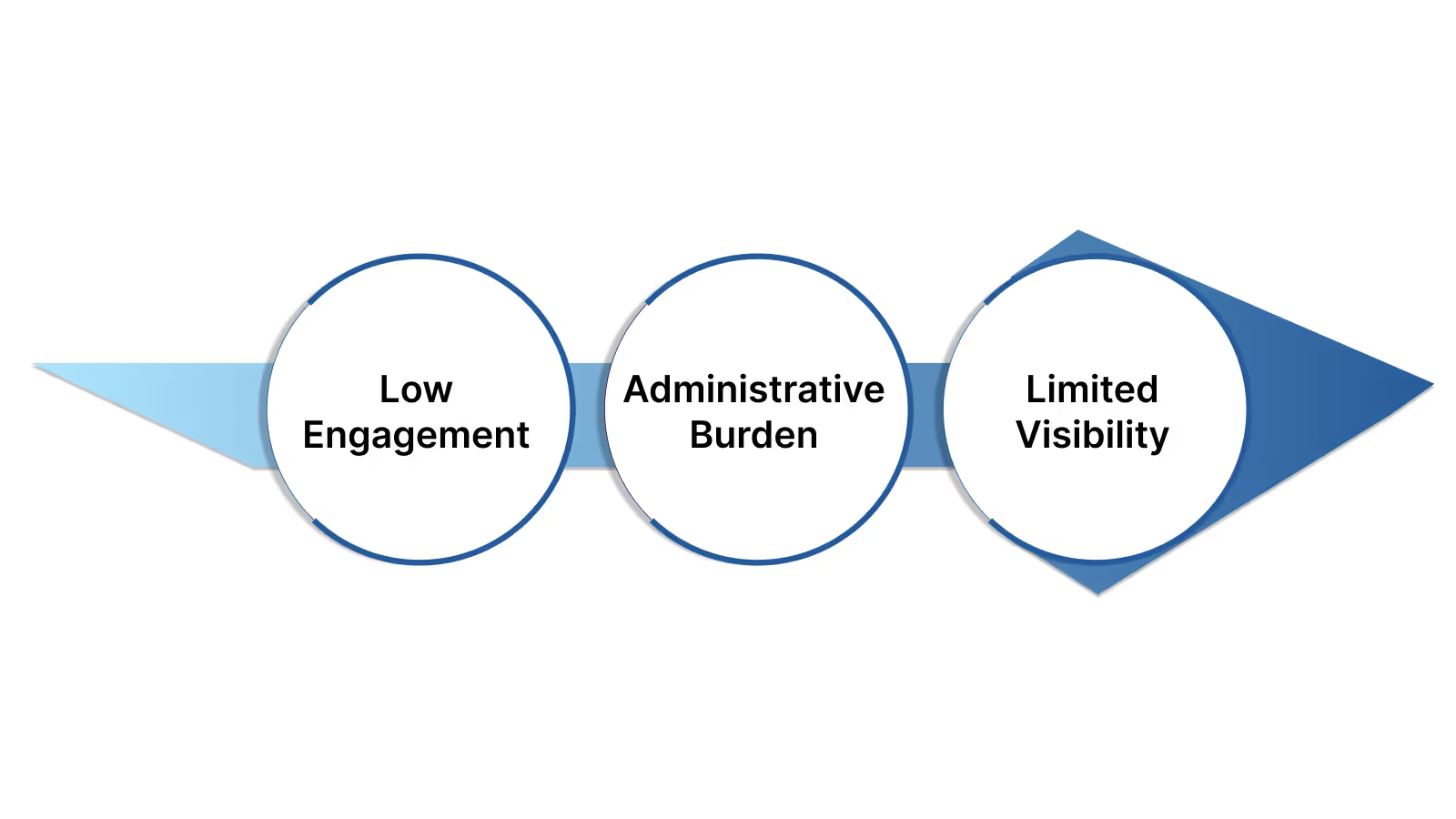
Even well-structured digital rewards programs can run into problems. These challenges are less about intent and more about execution. Identifying them early lets you refine the system before engagement dips or the workload becomes unmanageable.
1. Low Engagement
Many programs start strong but quickly lose momentum. A common reason? Rewards feel too generic. A flat “one-size-fits-all” option rarely motivates a wide range of participants, and without a sense of progress, people lose interest.
Engagement tends to improve when programs offer choice, variety, and a sense of progression, like earning toward tiers or selecting from a catalog of meaningful rewards. It shifts the experience from a one-off perk to something people want to keep participating in. Tools like Nector make it easier to design programs with tiered structures and varied rewards, so different types of participants can find something that resonates with them.
2. Administrative Burden
For many teams, running a rewards program becomes a second job. Manually tracking points, issuing rewards, and compiling reports can work for a small pilot, but as participation grows, these tasks quickly become unmanageable.
A system that automates delivery, syncs data in real time, and simplifies reporting allows your team to spend less time on admin work and more time refining strategy.
3. Limited Visibility
When program data lives in static spreadsheets or you’re only reviewing metrics quarterly, it’s hard to spot issues early. If engagement drops or a reward underperforms, you may not notice until it’s too late to act.
Real-time visibility into engagement and redemption trends allows for quick, informed adjustments, whether that means updating earning rules, refreshing reward options, or changing communications.
With the right structure and supporting technology, these challenges stop being constant headaches and instead become manageable parts of a program that improves over time.
Related Reads: Enhance Customer Reviews with Nector.io & Judge.me Integration
Measuring Success with Digital Rewards
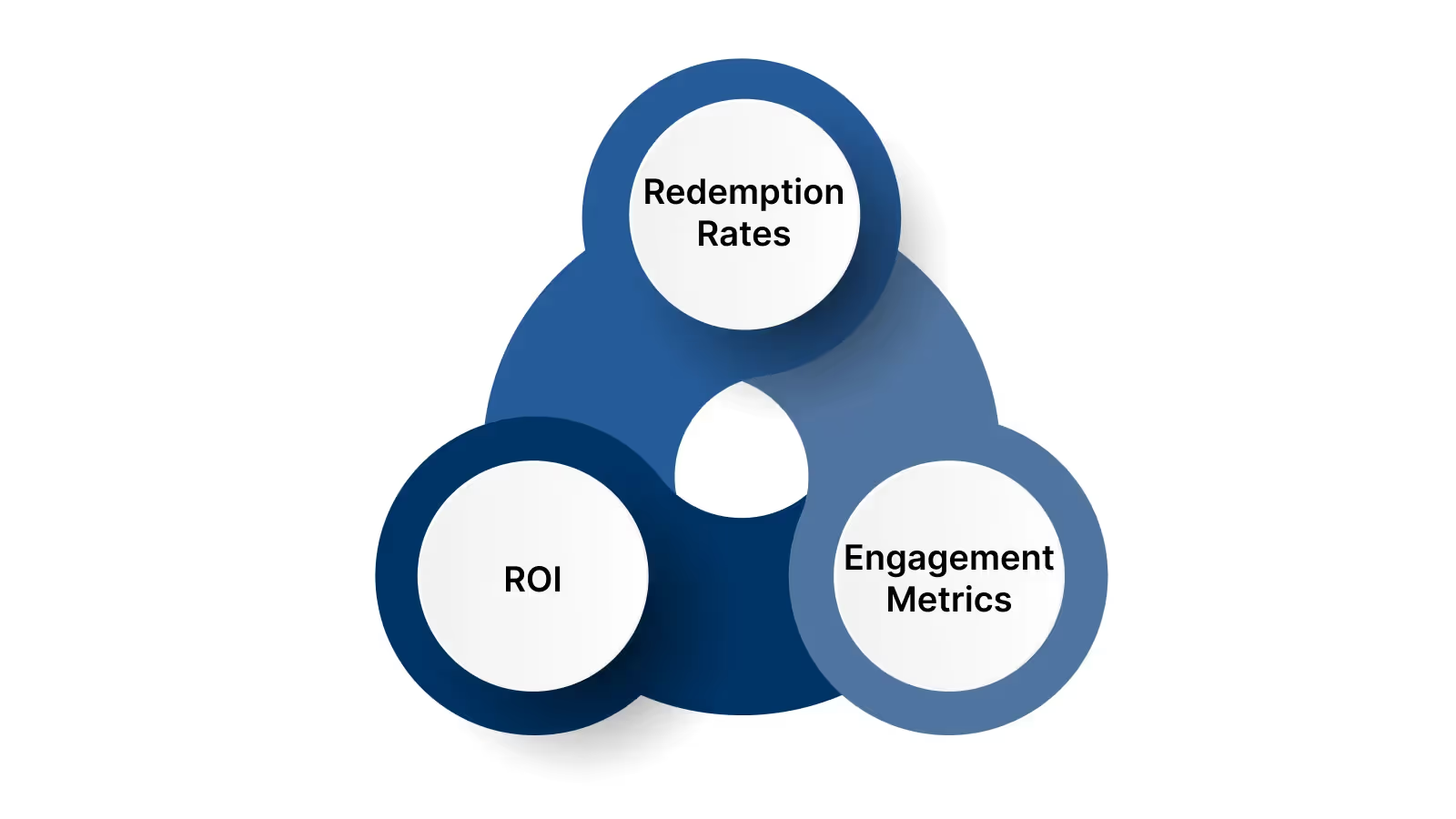
A digital rewards program isn’t valuable just because it feels good; it’s valuable when it drives measurable change. Without clear metrics, you can’t tell whether your efforts are building loyalty or just adding cost. The most useful measures tend to fall into three categories:
- Redemption rates: If people aren’t redeeming rewards, they probably don’t find them relevant. Tracking redemption tells you if what you’re offering matches participant expectations.
- Engagement metrics: Look at behaviors like repeat purchase frequency, referral activity, or employee participation in recognition programs. These numbers show whether rewards are driving the actions you care about most.
- ROI: Compare program costs against tangible outcomes higher revenue, improved retention, or reduced employee turnover. This helps you justify the program as a business growth lever, not just a morale booster.
When these metrics are tracked consistently, you can move beyond intuition and make data-driven adjustments, whether that’s refining reward options or rethinking earning rules. Platforms like Nector simplify this process by consolidating engagement, redemption, and ROI data into one dashboard, making it easier for teams to act on what they learn instead of chasing reports.

Final Thoughts
A rewards program should do more than distribute perks; it should create meaningful touchpoints that strengthen your relationship with the people who matter most: your customers and employees. Relevance, simplicity, and consistency are what drive engagement over time.
When you align rewards with real behavior, integrate them into everyday workflows, and measure their impact, the program becomes more than a feel-good initiative. It becomes a tool for sustainable growth. If you’re planning your next step, focus on what makes rewards feel worth it, not just to you, but to the people you're rewarding.
FAQs
What types of businesses benefit most from electronic rewards?
Any organization aiming to engage employees or customers can benefit from small D2C startups to enterprise HR teams managing large-scale recognition programs.
How do electronic rewards differ from traditional ones?
They’re instant, more customizable, and easier to manage. Digital delivery eliminates shipping delays and physical inventory issues.
Are digital rewards secure?
Yes, if managed through GDPR-compliant platforms with encrypted delivery. Always vet providers for data security standards.
Can I combine multiple types of rewards?
Absolutely. Many businesses blend gift cards, points, and experiential rewards for a more holistic approach.
How do I measure the effectiveness of a reward program?
Track redemption rates, program participation, repeat purchases (for customers), and performance improvements (for employees).
Start Building Customer Retention That Lasts


